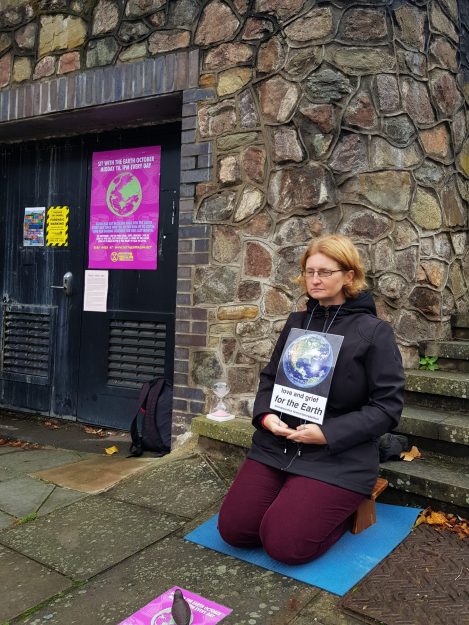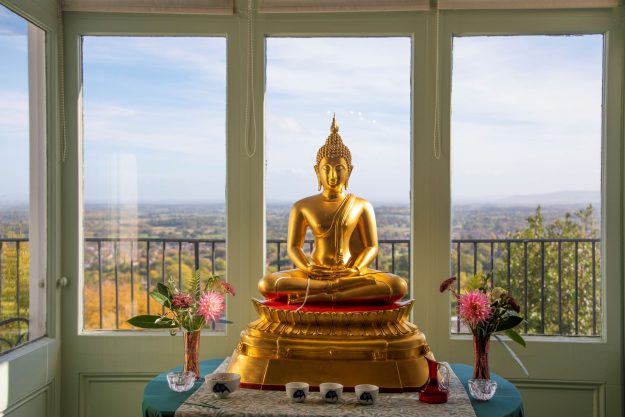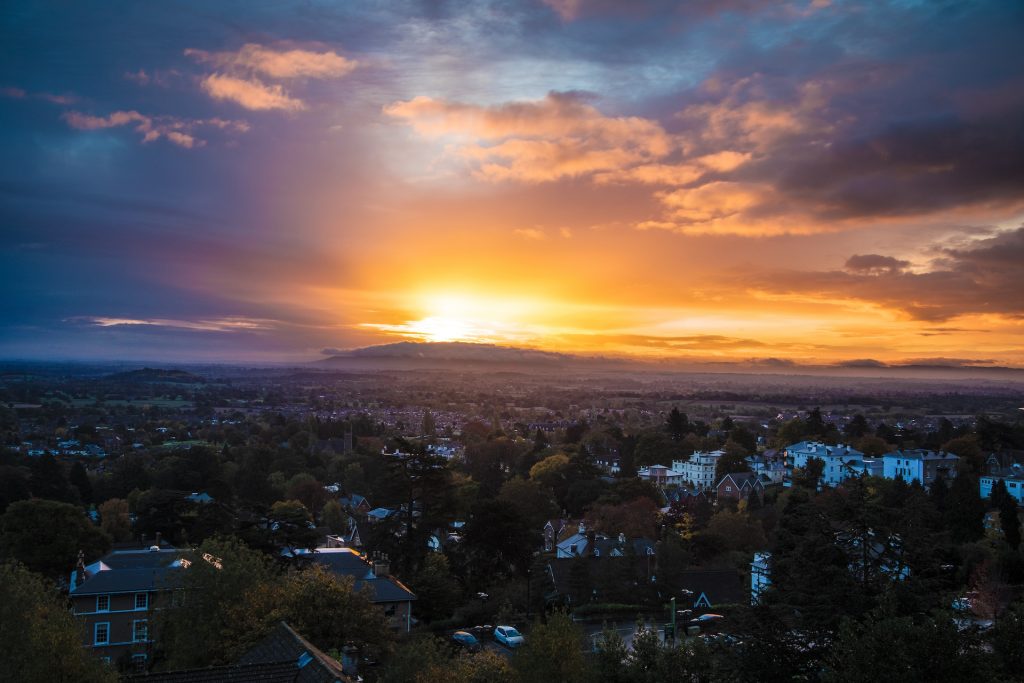Stepping inside from the busy street, I was drawn as if by a magnet to the hotel bar, where huge bay windows looked out across the Severn Valley in the West Midlands region of England. The land swept down and away, dotted with trees and fields, until it faded into hazy blue hills in the distance.
At the time, I thought to myself: Here is a view I will never tire of. We have been looking at it for more than a decade now, ever since my spouse, Kaspa, and I first moved into the hotel and converted it into a Pure Land Buddhist temple. The view changes color by the hour and by the season, and is also a constant presence—holding the temple in loving hands.
The proximity of the temple to nature felt appropriate to both of us as we began to form a local community. Kaspa and I had always found refuge in the landscapes around us. As the temple settled into a weekly practice schedule, we added occasional starlit chanting on the hills.
Our sangha’s connection with the Earth deepened naturally over time. During the pandemic, when the temple was closed to the public, a time came when we were allowed to welcome people into the temple garden. We got into a new routine of gathering around our garden Buddha to chant before slowly following the paths around the frogspawn-filled pond, the rustling bamboo, the tall willow. We walked in crunchy snow and baking sun, accompanied by blackbird song. When the temple opened up again, we couldn’t imagine not continuing this, so we kept the mindful walk as a regular part of our weekly schedule.
Kaspa and I also became involved in ecoactivism as part of a group called Extinction Rebellion Buddhists. I completed a yearlong vigil, sitting in meditation for an hour a day on the steps in the center of our town. I dressed for all types of weather and wore a placard around my neck—a photo of the Earth seen from space, with the words: love and grief for the Earth. We also got involved in nonviolent direct action and were arrested several times—meditating on central roads, blocking the entrances to oil companies, and occupying London bridges alongside other faith groups.

Six years ago, when a few of us left our order to become an independent Buddhist sangha, we found ourselves needing a new name. It felt natural to settle on the word “Earth.” We put this together with the word “Bright,” inspired both by Amitabha Buddha’s infinite light and the name of the Bright Dawn Center of Oneness, a Buddhist group we’d studied with. We would be “Bright Earth.”
Our connection with the Earth has remained central to our practice here. One of our Bright Earth ministers is an ecologist. Another regularly attends walking retreats with a different Buddhist group, and another finds their retreat space by wild camping in local forests. We have been taking refuge in the Earth in various ways for many years. Then, in February of this year, our colleague minister Rev. Ananda (who leads a congregation in Hawaii) wrote this in our ministry WhatsApp group:
“I know that for some of us that were trained as traditional Buddhists this may sound heretical, but I am wondering if the earth itself should actually be one of the refuges? I know that from the world denying schools of Buddhism this is a non-starter because they are very dualistic and consider anything material unreliable as a refuge. And yet here we are as embodied beings that completely rely on the earth for our daily existence. Thoughts?”
My first thoughts were no way! I already felt heretical enough, having stepped away from the culturally approved institution of lineage to set up as an independent school. We were also already seen as a little odd by some of our Buddhist colleagues from other schools. Our Pure Land roots give our practice a devotional lean, and we are unusually open to teachings from other religious traditions. Having a fourth refuge would make us even weirder in the eyes of our fellow Buddhists.
What do we actually mean when we say we take refuge in the Earth? For me, just like my refuge in the Buddha, dharma, and sangha, it is multidimensional.
I also had a strong resistance to “messing” with this central tenet of Buddhism. Everyone knew that all Buddhists had three refuges—it’s one of the few things that unites us all. If we adopted this, what would be next—rewriting the four noble truths?
Over time, however, I softened toward the idea. I try to be someone who takes action because it is the right action, not because it is approved of by those around me. Of course we should consult with our more senior colleagues and take their opinions into account. After that, we should do what we feel is right, rather than just doing what the culture around us finds acceptable. I had learned this hard lesson during my engagement with ecoactivism. Our governments are not acting to protect us or our planet. They see the terrible consequences of their current policies, and they choose instead to continue to follow the money (and power). We can’t always trust those in authority—we need to be able to think for ourselves.

Rev. Ananda reminded us that other schools of Buddhism had already added to the list of three refuges, including adding particular gurus. In our old order we had five refuges—taking refuge in Amitabha and in the Pure Land in addition to Shakyamuni Buddha, the dharma, and the sangha.
And yet this fourth refuge felt so essential. It made me recall two of my favorite dharma quotes. The first is by Dogen:
“Grasses and trees, fences and walls, tiles and pebbles all expound the Dharma.”
The second is from Shinran—the great Pure Land sage and my heart teacher:
“The Tathagatha pervades the countless worlds; it fills the hearts and minds of the ocean of all beings. Thus, plants, trees, and land all attain Buddhahood. Since it is with this heart and mind of all sentient beings that they entrust themselves to the Vow of Dharmakaya-as-compassion [Amitabha Buddha], this entrusting is none other than Buddha-nature.”
Plants, trees, and land all attain buddhahood. Could that really be true?
To test this out, my fellow ministers and I interrogated our own spiritual experience, alongside seeking the wisdom of great teachers. Could we really compare the Earth to the three jewels? Surely this enormous sphere of mostly molten rock is in a different category from the Buddha, dharma, and sangha, which are entirely lit up by the Buddha’s light? What about the cruelty of nature, what about concrete, what about the squabbling human race?
Well, maybe it depends on whose eyes we are looking through. We hear that the Buddhas see Buddhas everywhere. When I experience moments of looking through the eyes of a Buddha, I always find buddha-nature in nature—the frogs stretching out their legs into the cool of our pond on a hot day, clouds easing their way across the bright sky, the vast rippling pelt of the copper beech tree I see from my office window.
After contemplation and discussion, we decided to give it a go. Kaspa and I had already written a version of the three refuges, which we recited at every practice session:
For refuge I go to the Buddha
The one who is awake and full of love
Namo Buddhaya
For refuge I go to the Dharma
All that guides us to wisdom and compassion
Namo Dharmaya
For refuge I go to the Sangha
Those who live in the Buddha’s light
Namo Sanghaya
We played around with the wording for a fourth. In the end, it was Ananda who wrote the words we all liked best. And after consultation with some learned Buddhist colleagues, we settled on the Sanskrit word bhumaya to denote the Earth, with the correct ending in the context being yai. Taken together, we settled on:
I take refuge in the Earth,
the Holy ground of awakening
Namo Bhumyai
We began to recite all four refuges at our next practice session. It felt good.
What do we actually mean when we say we take refuge in the Earth? For me, just like my refuge in the Buddha, dharma, and sangha, it is multidimensional.
The fourth refuge reminds me of my utter dependence on the Earth. I am dependent on the Buddha, dharma, and sangha as the spiritual foundation of all that I do, but with the Earth there is a physical dependence too—without her, I wouldn’t live for more than six minutes. As well as oxygen, I need her for my food and water. She was the raw material for every single one of my ancestors. She is the literal ground under my feet.

Deeply appreciating this dependence takes me in two directions. The first is a profound gratitude for everything I receive, from the raspberries I pick from the garden to eat for breakfast, to the minerals and plastics necessary to make this computer. It also reaffirms how crucial it is that I do what I can to look after the Earth. We are already suffering from the effects of our greed as a species, and things will get much worse. We have a responsibility to take care of her. We should be doing this in small, individual ways—making ethical choices whenever we spend our money, eating a plant-based diet, reducing or giving up flying. We should also join with others wherever we can—not just by engaging in activism but by getting involved in local community groups or politics, forming ecological groups at our workplace, or whatever else we are called to do.
By acknowledging our dependence on dear Earth, and by connecting into gratitude for her amazing gifts, we will naturally move in the direction of living more lightly on her.
Taking refuge in the Earth directs my attention to the different ways in which the Buddha “shows up” to offer me teachings. Sometimes I forget and think that I’m “doing Buddhism” only when I’m in the shrine room or explicitly speaking about the teachings to members of my sangha. Of course the light of the buddhas penetrates all things. Connecting with the Earth reminds me that my “everyday life” is the ideal place to become a better student and, one hopes, a better conduit of the light—pointing others toward their own inspiration.
Finally, this refuge brings me great comfort. When I lie underneath our copper beech tree and look up through the shimmering leaves, I feel connected to everything.
I wonder how you might include the Earth in your usual Buddhist practice. Maybe you’ll bow to the sun or to a tree in your neighborhood before sitting down to meditate. Maybe you’ll take a weekly “nature walk” in slow motion amongst the office buildings, the scraps of park, and the birds. Maybe you’ll put a stone or a shell on your home shrine.
By acknowledging our dependence on dear Earth, and by connecting into gratitude for her amazing gifts, we will naturally move in the direction of living more lightly on her. We will also be more likely to speak up for her, and to take action against extractive capitalism, global injustices, and other wide-scale results of our greed, hatred, and delusion. Our Earth needs our respect and our care more than ever. Namo Bhumyai.
Thank you for subscribing to Tricycle! As a nonprofit, we depend on readers like you to keep Buddhist teachings and practices widely available.
